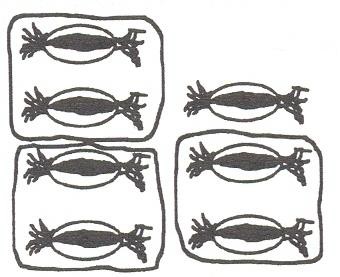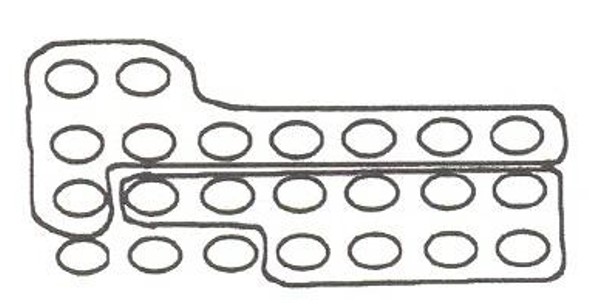Unit 2: Division
Topic A: Introduction and Division Facts
Division is an interesting operation. Both these signs tell you to divide:
[latex]8\div4[/latex] [latex]\require{enclose}4\enclose{longdiv}{8}[/latex]
Division is the opposite of multiplication.
Multiplication takes equal-sized groups and puts the groups together to find the total.
3 × 4 = 12
![]()
Division takes the total and separates that amount into equal groups. You can find the number of equal groups or the size of each group.
12 ÷ 4 = 3
![]()
| [latex]4 × 3 = 12[/latex] | [latex]12 ÷ 3 = 4[/latex] | [latex]\begin{array}{r}4\\3 \enclose{longdiv}{12} \end{array}[/latex] |
| [latex]3 × 4 = 12[/latex] | [latex]12 ÷ 4 = 3[/latex] | [latex]\begin{array}{r}3\\4 \enclose{longdiv}{12} \end{array}[/latex] |
Learn this vocabulary for division:
- Dividend – The number or quantity to be divided; the amount altogether.
- Divisor – The number we divide by. The divisor tells us the number of groups or the quantity in each group that the dividend is to be separated into.
- Quotient – (“kw ō shent”) The answer to a division question.
[latex]\begin{array}{r}\text{quotient}\\\text{divisor} \enclose{longdiv}{\text{dividend}}\end{array}[/latex] [latex]\text{dividend}\div\text{divisor}=\text{quotient}[/latex]
To use the times table chart for division facts:
- Find the divisor in the column on the left of the times table chart.
- Run your finger in a straight line across the divisor row until you come to the dividend.
- Go straight up that column and the quotient should be the top number.
Try a few while you are doing Exercise 1.
Exercise 1
Complete this chart to help yourself understand the connection between multiplication and division. The first one is done for you. Check your work using the answer key at the end of the exercise.
| # | Multiplication | Division | Division | “Say” |
|---|---|---|---|---|
| a |
|
|
|
|
| b |
|
|
|
|
| c | 3 × 7 = 21 | |||
| d | 5 × 9 = 45 | |||
| e | 4 × 6 = 24 | |||
| f | 2 × 8 = 16 | |||
| g | 7 × 10 = 70 | |||
| h | 6 × 9 = 54 | |||
| i | 9 × 4 = 36 | |||
| j | 6 × 7 = 42 |
Answers to Exercise 1
| # | Multiplication | Division | Division | “Say” |
|---|---|---|---|---|
| a |
|
|
|
|
| b |
|
|
|
|
| c |
|
|
|
|
| d |
|
|
|
|
| e |
|
|
|
|
| f |
|
|
|
|
| g |
|
|
|
|
| h |
|
|
|
|
| i |
|
|
|
|
| j |
|
|
|
|
Exercise 2
Check your division facts by quickly doing this exercise. Check your work using the answer key at the end of the exercise.
- 72 ÷ 6 =
- 12 ÷ 2 =
- 3 ÷ 1 =
- 80 ÷ 10 =
- 18 ÷ 6 =
- 40 ÷ 4 =
- 21 ÷ 7 =
- 50 ÷ 5 =
- 54 ÷ 9 =
- 8 ÷ 2 =
- 22 ÷ 11 =
- 45 ÷ 9 =
- 4 ÷ 4 =
- 24 ÷ 6
- 81 ÷ 9 =
- 88 ÷ 8 =
- 30 ÷ 3 =
- 12 ÷ 4 =
- 33 ÷ 3 =
- 66 ÷ 11 =
- 20 ÷ 5 =
Answers to Exercise 2
- 12
- 6
- 3
- 8
- 3
- 10
- 3
- 10
- 6
- 4
- 2
- 5
- 1
- 4
- 9
- 11
- 10
- 3
- 11
- 6
- 4
Exercise 3
Check your division facts by quickly doing this exercise. Check your work using the answer key at the end of the exercise.
- 90 ÷ 10 =
- 70 ÷ 7 =
- 28 ÷ 7 =
- 32 ÷ 8 =
- 24 ÷ 3 =
- 36 ÷ 12 =
- 84 ÷ 7 =
- 10 ÷ 2 =
- 64 ÷ 8 =
- 6 ÷ 6 =
- 60 ÷ 12 =
- 48 ÷ 4 =
- 72 ÷ 9 =
- 20 ÷ 10 =
- 49 ÷ 7 =
- 48 ÷ 6 =
- 36 ÷ 9 =
- 21 ÷ 3 =
Answers to Exercise 3
- 9
- 10
- 4
- 4
- 8
- 3
- 12
- 5
- 8
- 1
- 5
- 12
- 8
- 2
- 7
- 8
- 4
- 7
Exercise 4
Check your division facts by quickly doing this exercise. Check your work using the answer key at the end of the exercise.
- 12 ÷ 6 =
- 27 ÷ 9 =
- 56 ÷ 7 =
- 3 ÷ 1 =
- 20 ÷ 2 =
- 9 ÷ 3 =
- 55 ÷ 5 =
- 14 ÷ 7 =
- 42 ÷ 6 =
- 18 ÷ 3 =
- 88 ÷ 11 =
- 63 ÷ 9 =
- 28 ÷ 4 =
- 6 ÷ 1 =
- 30 ÷ 5 =
- 4 ÷ 2 =
- 7 ÷ 7 =
- 48 ÷ 12 =
Answers to Exercise 4
- 2
- 3
- 8
- 3
- 10
- 3
- 11
- 2
- 7
- 6
- 8
- 7
- 7
- 6
- 6
- 2
- 1
- 4
Remainders
You have been practicing the division facts that always work out evenly – nothing is left over.
Well, in the real world things are not usually so perfect!
You have 7 candies to share among your 3 children.

We call the left-over the remainder. For now, put R and the left over number after your quotient.
[latex]7\div3=2\text{ R}1[/latex] [latex]\begin{array}{r}2\text{ R}1\\3 \enclose{longdiv}{7}\hspace{1.3em}\end{array}[/latex]
Example A
Here are 22 cookies. Circle groups of 5. How many groups of 5 in 22?

You should have 4 groups with 2 left over.
[latex]22\div5=4\text{ R}2[/latex] [latex]\begin{array}{r}4\text{ R}2\\5 \enclose{longdiv}{22}\hspace{1.3em}\end{array}[/latex]
The remainder must not be the same size or bigger than the divisor. If it is bigger, it means another group could be made.
Example B
Here are 66 suns. Make groups of 9. How many groups of 9 in 66?

How many groups? 7
How many left over? 3
[latex]66\div9=7\text{ R}3[/latex] [latex]\begin{array}{r}7\text{ R}3\\9 \enclose{longdiv}{66}\hspace{1.3em}\end{array}[/latex]
Exercise 5
Draw pictures to find the quotient and the remainder. Write each question using the other division sign as well. Have your instructor check your work.
- [latex]23\div10=2\text{ R}3[/latex] [latex]\begin{array}{r}2\text{ R}3\\10 \enclose{longdiv}{23}\hspace{1.3em}\end{array}[/latex]

- 24 ÷ 7 =
- 19 ÷ 3 =
- 39 ÷ 12 =
You cannot always draw pictures, so how should you find the quotients?
Example C
29 ÷ 3 =
Use multiplication tables or the division facts to find a trial quotient. What can you multiply by 3 to find a number close to 29?
- 3 × 9 = 27
- 3 × 10 = 30
Use 9 as the trial quotient. Do not use 10 because 3 × 10 = 30, which is more than the dividend 29.
- Divide.
[latex]\begin{array}{r}9\\3 \enclose{longdiv}{29}\end{array}[/latex] - Multiply. 9 × 3 = 27. Write the product under the 29.
[latex]\begin{array}{r}9\\3 \enclose{longdiv}{29}\\27\end{array}[/latex] - Subtract 27 from 29 to find the remainder.
[latex]\begin{array}{r}9\\3 \enclose{longdiv}{29}\\-27\\\hline2\end{array}[/latex] - Check (compare) to be sure the remainder is less then (<) the divisor.
2 < 3
29 ÷ 3 = 9 R2
Example D
60 ÷ 7 =
Think what can be multiplied by 7 to find a number close to 60.
- 7 × 8 = 56 (good)
- 7 × 9 = 63 (too big)
Use 8 as the trial quotient.
- Divide.
[latex]\begin{array}{r}8\\7 \enclose{longdiv}{60}\end{array}[/latex] - Multiply.
[latex]\begin{array}{r}8\\7 \enclose{longdiv}{60}\\56\end{array}[/latex] - Subtract.
[latex]\begin{array}{r}8\\7 \enclose{longdiv}{60}\\-56\\\hline4\end{array}[/latex] - Compare to be sure the remainder is less than the divisor.
4 < 7
60 ÷ 7 = 8 R4
Exercise 6
Find the quotients and remainders (divide, multiply, subtract, compare). Check your work using the answer key at the end of the exercise.
- [latex]5\enclose{longdiv}{28}[/latex]
- [latex]4\enclose{longdiv}{15}[/latex]
- [latex]6\enclose{longdiv}{47}[/latex]
- [latex]9\enclose{longdiv}{37}[/latex]
- [latex]2\enclose{longdiv}{13}[/latex]
- [latex]6\enclose{longdiv}{25}[/latex]
- [latex]8\enclose{longdiv}{75}[/latex]
- [latex]3\enclose{longdiv}{19}[/latex]
- [latex]7\enclose{longdiv}{32}[/latex]
- [latex]4\enclose{longdiv}{9}[/latex]
- [latex]9\enclose{longdiv}{55}[/latex]
- [latex]10\enclose{longdiv}{98}[/latex]
- [latex]3\enclose{longdiv}{26}[/latex]
- [latex]8\enclose{longdiv}{47}[/latex]
- [latex]9\enclose{longdiv}{46}[/latex]
- [latex]6\enclose{longdiv}{43}[/latex]
- [latex]5\enclose{longdiv}{49}[/latex]
- [latex]4\enclose{longdiv}{38}[/latex]
- [latex]2\enclose{longdiv}{19}[/latex]
- [latex]7\enclose{longdiv}{61}[/latex]
- [latex]3\enclose{longdiv}{23}[/latex]
- [latex]8\enclose{longdiv}{78}[/latex]
- [latex]9\enclose{longdiv}{67}[/latex]
- [latex]6\enclose{longdiv}{45}[/latex]
Answers to Exercise 6
- 5 R3
- 3 R3
- 7 R5
- 4 R1
- 6 R1
- 4 R1
- 9 R3
- 6 R1
- 4 R4
- 2 R1
- 6 R1
- 9 R8
- 8 R2
- 5 R7
- 5 R1
- 7 R1
- 9 R4
- 9 R2
- 9 R1
- 8 R5
- 7 R2
- 9 R6
- 7 R4
- 7 R3
Exercise 7
Find the quotients and remainders (divide, multiply, subtract, compare.) Check your work using the answer key at the end of the exercise.
Example
59 ÷ 7 =
Rewrite: [latex]7\enclose{longdiv}{59}[/latex]
Then solve: [latex]\begin{array}{r}8\\7 \enclose{longdiv}{59}\\-56\\\hline3\end{array}[/latex]
Answer: 8 R3
- 27 ÷ 5 =
- 13 ÷ 2 =
- 46 ÷ 9 =
- 38 ÷ 6 =
- 61 ÷ 7 =
- 14 ÷ 5 =
- 49 ÷ 8 =
- 28 ÷ 3 =
- 78 ÷ 8 =
- 37 ÷ 4 =
- 67 ÷ 9 =
- 52 ÷ 6 =
- 45 ÷ 8 =
- 25 ÷ 7 =
- 11 ÷ 3 =
- 53 ÷ 9 =
- 19 ÷ 4 =
- 77 ÷ 8 =
- 20 ÷ 3 =
- 11 ÷ 2 =
- 23 ÷ 5 =
- 54 ÷ 7 =
- 87 ÷ 9 =
- 9 ÷ 4 =
Answers for Exercise 7
- 5 R2
- 6 R1
- 5 R1
- 6 R2
- 8 R5
- 2 R4
- 6 R1
- 9 R1
- 9 R6
- 9 R1
- 7 R4
- 8 R4
- 5 R5
- 3 R4
- 3 R2
- 5 R8
- 4 R3
- 9 R5
- 6 R2
- 5 R1
- 4 R3
- 7 R5
- 9 R6
- 2 R1
Topic A: Self-Test
Mark /12 Aim 9/12
- Give the answer. (6 marks)
- 63 ÷ 9 =
- 21 ÷ 7 =
- 72 ÷ 8 =
- 65 ÷ 4 =
- 86 ÷ 4 =
- 75 ÷ 6 =
- Find the quotient. (6 marks)
- [latex]6\enclose{longdiv}{59}[/latex]
- [latex]9\enclose{longdiv}{87}[/latex]
- [latex]7\enclose{longdiv}{51}[/latex]
- [latex]8\enclose{longdiv}{76}[/latex]
- [latex]5\enclose{longdiv}{49}[/latex]
- [latex]3\enclose{longdiv}{26}[/latex]
Answers to Topic A Self-Test
- Give the answer.
- 7
- 3
- 9
- 9
- 8
- 8
- Find the quotient.
- 9 R5
- 9 R6
- 7 R2
- 9 R4
- 9 R4
- 8 R2

